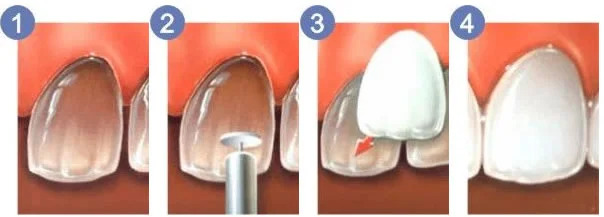Today’s technological advances have afforded a great deal of flexibility in modern dentistry. We can now treat a wider range of concerns with more precision and less invasive techniques. Ultimately, this has lead to more “conservative” treatment options- solving the same problems with less collateral interference. One of the best examples of this new approach and ideology is the rise and popularity of dental veneers.
Although veneers have been around for many years, new technology has made them an excellent long-term treatment option for esthetic concerns. In it’s most basic form, a veneer is a thin piece of material that is used to replace the lip side of anterior (“smiling”) teeth. This material is made by a dental lab and used to correct the shape, color, length or spacing of the teeth.
1) an existing tooth has become discolored or misshapen. 2) a minimal amount of tooth structure is removed to accommodate the new veneer 3) The new veneer is tried on to ensure esthetics 4) the final product is adjusted and cemented
In the spectrum of cosmetic dentistry, veneers occupy the space between cosmetic bonding and full coverage crowns. Large deficits in size and shape cannot be reliably addressed with bonding composites. Since a veneer is a single piece of solid material, it offers more overall rigidity. Additionally, a veneer can be made to match adjacent teeth in ways bonding never can. Color gradients, shapes and artifacts can all be added to the veneer to make it blend in perfectly with the rest of your smile. Conversely, since veneers only address cosmetic concerns, they are less invasive than a full coverage crown. Less natural structure has to be removed as the underlying tooth is still structurally sound.
A number of recent technological developments have perfected veneer preparation and placement. We now make veneers out of an engineered lithium disilicate called Emax. Emax is a translucent, tooth colored material that combines unmatched esthetics and incredible strength. It is perfect for anterior teeth as it is both functional and beautiful. The labs we work with will schedule a shade-matching appointment to make sure your Emax unit is flawlessly matched to your surrounding teeth. They will help guarantee that the color, gradient, shape, length and width are in perfect harmony with the rest of your mouth.
In addition to developments in the veneer material, the bonding agents we use have made the process easier and more predictable than ever. Since Emax is extremely translucent, the color of the underlying “glue” can severely alter the appearance of the final product. With this in mind, we use a combination of clear cement and mock try-in material known as Cosmedent Insure/Prevue. The Prevue material has the same viscosity and value as the Insure cement, and allows us to confirm esthetics without actually cementing the veneer. Once we are satisfied with the esthetics of the restoration, Insure is used to create a strong, lasting bond.
If you have one, two or more defects or deficiencies in your anterior teeth, veneers could be an excellent option to restore your beautiful smile. At our office, we place veneers to fix everything from single teeth to entire anterior arches. However, we evaluate each case for its appropriateness to be solved with veneers. Often times a combination of cosmetic bonding, orthodontics and smoothing/disking can offer similar results, albeit with a different time frame. If you are considering veneers, we urge you to schedule a consultation with Dr. Kari to best evaluate your personal needs, desires and expectations from our treatment!


